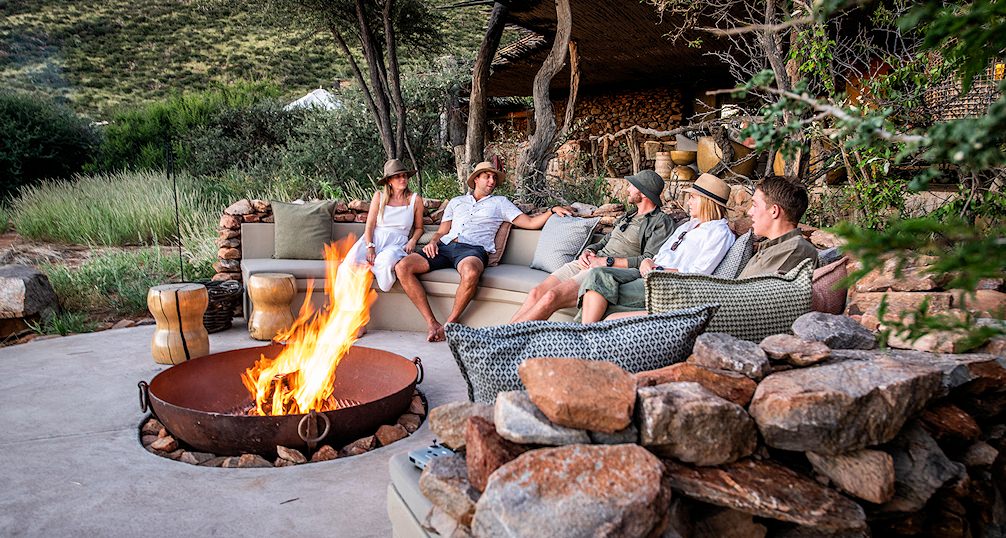Top Alternative Safari Destinations in South Africa

South Africa's famous diversity extends to its bewitching wilderness areas. Below are the most highly recommended alternative safari destinations.
These destinations are ideal for the adventurous who like to venture off the beaten track. There are many hidden gems as far as National Parks are concerned. Though all may not offer Big Five Game viewing, each protects unique Fauna and Flora and offers exceptional natural interaction.

The Wonderful World of the Waterberg – Marataba Safari Lodge
Marataba is a unique South African safari destination because of the emphasis on a variety of safari activities (rather than just your traditional 4x4 game drives). The sprawling 23 000-hectare concession forms part of the Limpopo province’s 67 000-hectare Marakele National Park, ensuring a generous free flow of wildlife (including the Big Five). Unlike concessions in other national parks or private game reserves, however, Marataba’s traversing rights belong to only two lodges – Marataba Safari Lodge and Marataba Trails Lodge. That’s a whole lot of pristine wilderness for only a maximum of 38 guests at any given time.
In addition to only the most minimal traffic from the two lodges’ 4x4 game drive vehicles, Marataba offers water-based safaris – one of only two South African safari areas able to do so (the other being Phinda in Zululand).
Cruises on the perennial Matlabas River are conducted at sunrise and sunset – the finest times to glide along and watch the rising or setting sun bleed all shades of scarlet, pink and gold over the spectacular cliff faces of the Waterberg Mountains. The vessel – dubbed the ‘Miss Mara’ – is small and unobtrusive, providing an intimate experience afforded to only a handful of passengers. Scrumptious snacks and beverages are served aboard. If you’re lucky, you’ll encounter elephants as they wander over to the river for a drink or a swim. Observing them from your perch on the water is a truly unique and memorable experience.

Marataba Safari Lodge – the main lodge – can host a maximum of 30 guests in 15 ultra-luxurious tented-style suites. Owned by the well-lauded and family-run MORE company, you can expect the same attention to detail, delicious food, impeccable service and characteristic warmth that have become hallmarks of MORE-owned properties. While inherently romantic – a fantastic choice for honeymoon couples - Marataba Safari Lodge is also a great family safari destination, as children aged 6 and older are welcome, and the concession is located in a malaria-free wilderness area.
Marataba Mountain Lodge – the latest edition to the MORE portfolio – is a handsome, intimate property perched on the side of a mountain, ceding spectacular views across the reserve.
As its name suggests, the solar-powered eco lodge focuses on interpretive walking safaris in the Waterberg wilderness. Mountain Lodge can only host a maximum of eight guests, which also makes it ideal for groups. Guests enjoy the option of focusing solely on comprehensive full day walking safaris or splitting their time to include game drives and/or cruises on Miss Mara.
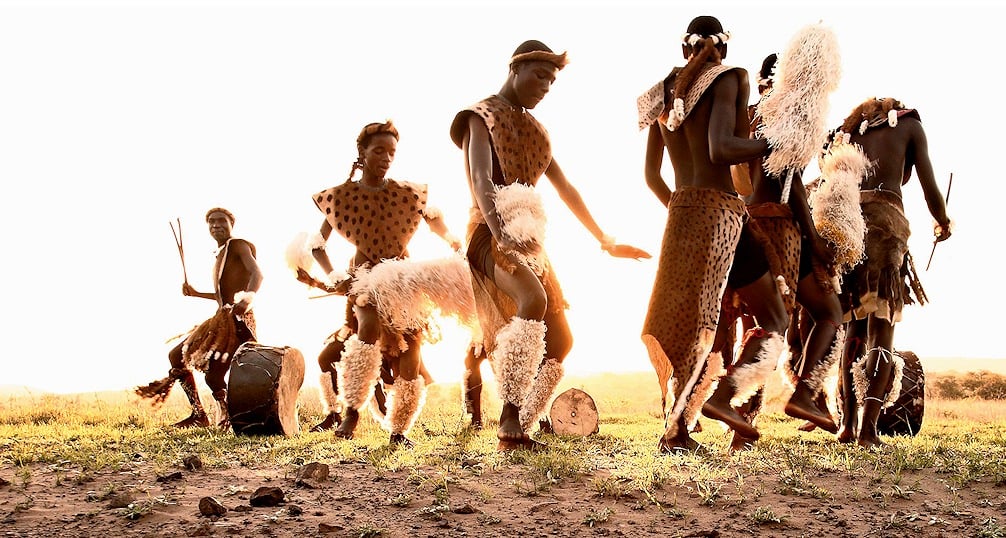
Kingdom of Legends – Big Five Safaris in Zululand
The Zululand region in South Africa’s KwaZulu-Natal province is known for being the birthplace and traditional home of the proud Zulu people, a nation of warriors with such a rich history and such unique traditions that many of their stories have transcended fact into the stuff of legend. Zululand, however, also happens to be one of the finest and most inimitable safari areas on the continent, hosting the legendary Big Five along with myriad other mammals, remarkable birdlife and rare ecosystems.
The cream of the crop is the Phinda Private Game Reserve, which covers 23 000 hectares of wilderness consisting off no less than seven distinct ecosystems.
These environs range from the extraordinary sand forest and mountainous bushveld to grassy wetlands and rocky outcrops. Significantly, the reserve is a stone’s throw from Sodwana Bay, with its incomparable coral reefs and leagues of unspoiled, wild beaches. This combination allows for a wealth of unique safari activities.
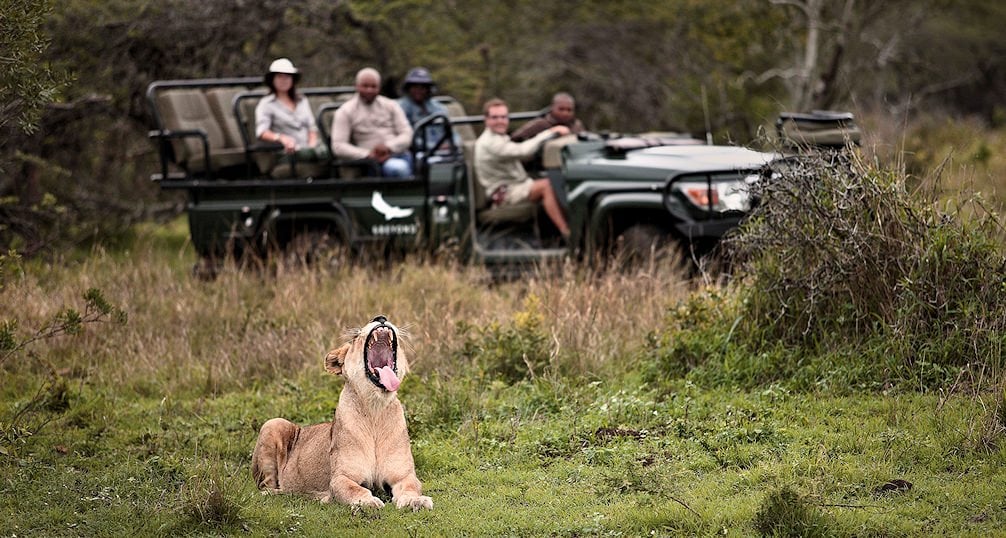
Your traditional twice daily game drives in open 4x4 vehicles and late morning bush walks are included in the rate at Phinda, along with leisurely river cruises. For an additional fee, however, you can sleep under the stars in the wilderness, shielded only by a billowing mosquito net and an armed Phinda ranger, or track the endangered black rhino on foot in the company of an expert guide. Beyond the confines of the reserve, you can partake in an ocean safari (no experience required) or scuba diving (some experience required) in the Indian Ocean off the coast of Sodwana Bay.
Back on land, you can partake in a turtle nesting adventure between the months of November and February. This typically takes place late in the evening, when the enormous female leatherback and loggerhead turtles emerge from the sea to lay their eggs in the sand.
On the fringes of Phinda, you can visit the nearby Endangered Wild Cats Project for insight into the plight of Africa’s threatened feline species. You will be guided through enclosures hosting cheetahs, caracals, servals and African wild cats. For something altogether unique and cultural, opt for a guided visit to an authentic Zulu homestead.
Phinda hosts guests in five ultra-luxurious lodges fit for royalty. The lodges – Forest, Rock, Mountain, Vlei and Zuka – are mainly characterized by their surroundings. In terms of wildlife, in addition to the famous ‘Big Five’ (lion, leopard, elephant, black rhino and buffalo), Phinda is also home to cheetahs, white rhinos and rarely spotted antelope like nyalas, red duikers and the tiny suni. Phinda is also a birder’s paradise, with 436 bird species recorded within the reserve.
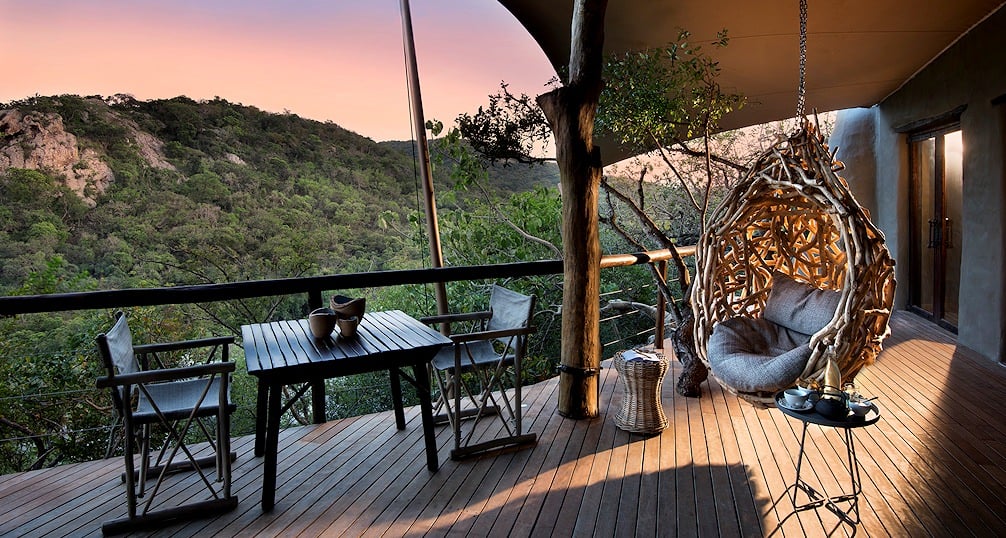
Despite andBeyond’s best efforts and millions spent on security for its rhinos, rampant poaching remains a horrible reality for most South African safari areas that protect rhinos. Phinda’s rhinos were dehorned in 2016 to save them from potential slaughter and curb the scourge of poaching. The good news is that the horns will grow back, and the reserve is hoping that the dehorning will simply be an interim measure that will significantly reduce the threat of poaching.
For those on a more moderate budget or with frills-free travel tastes, the historic Hluhluwe-iMfolozi Park is a fine choice for a Big Five safari in South Africa. It can also easily be combined with an overland Kruger Park safari, with a cultural one-night interlude in the tiny Kingdom of Swaziland en route. The 96 000-hectare wilderness area, managed by the provincial Ezemvelo KZN Wildlife, happens to be the continent’s oldest proclaimed game reserve. Established in 1895, it was once the hunting ground of Zulu kings and legends of centuries past.
In the 1950s and 60s, Hluhluwe became the home of Operation Rhino, driven largely by then-park warden and famous conservationist Ian Player. The reserve established a breeding program that brought the white rhino back from the brink of extinction, and now hosts the largest population of white rhino in the world. Its internationally renowned Game Capture unit recently upgraded into the Centenary Capture Centre, a benchmark for animal capture and sustainable utilization throughout Africa.
Our top choices for accommodation in Hluhluwe-iMfolozi are the reserve’s flagship accommodation, Hilltop Camp (operated by Ezemvelo), and the community-run Rhino Ridge Safari Lodge, a luxury personal property set within a private concession. In addition to encounters with the Big Five, Hluhluwe-iMfolozi is a fantastic place to encounter the elusive nyala, while birders will delight in sightings of some 340 different species of bird. The park’s proximity to the iSimangaliso Wetland Park means that day trips and boat cruises on the spectacular Lake St Lucia have become standard for Hilltop Camp guests.
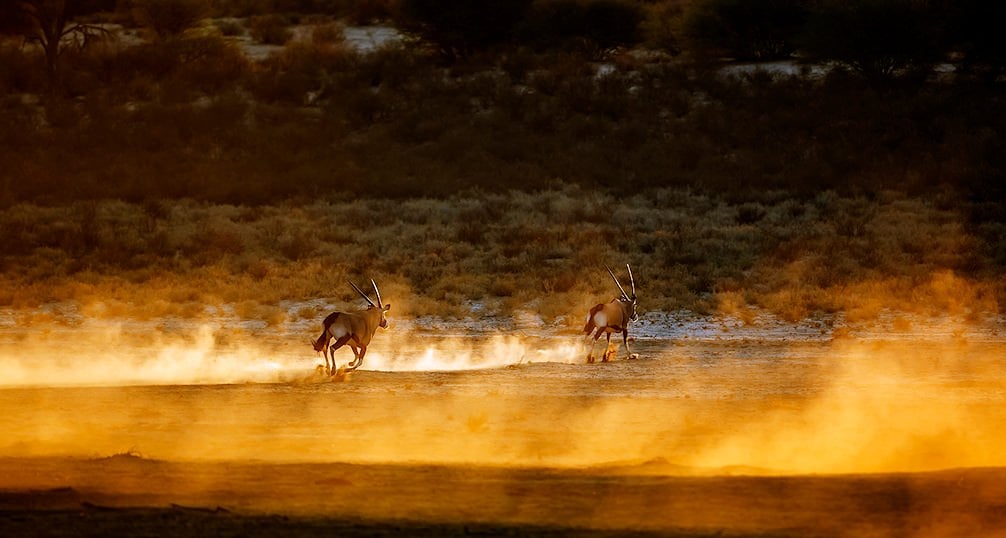
The Living Desert – Kgalagadi Transfrontier Park
The Kgalagadi Transfrontier Park stretches across a whopping 3.5 million hectares of southern Kalahari in Botswana and South Africa. It is the continent’s first transfrontier park, established in 2000 when Botswana’s Gemsbok National Park and South Africa’s Kalahari Gemsbok National Park merged into a mega conservation area. The park is named for some of the area’s earliest inhabitants – the Kgalagadi - who gave the Kalahari its name, meaning ‘the great thirstland’. Indeed, this sandy wilderness has a long-term rainfall average of just 213mm per annum, which classifies it as a true desert. However, underground water nourishes the desert grasses and camelthorn trees, sustaining a startling abundance of life.
While the park’s large mammal specie diversity may not be comparable to, for example, the Greater Kruger or Zululand, sightings here are inherently dramatic. With unobstructed views across the savanna, the animals appear larger than life, particularly the imposing black-maned Kalahari lions. Other prominent predators include leopards, cheetahs, African wild dog and both brown and spotted hyenas.
Due to the sparse vegetation, lesser mammals are more frequently spotted than in other wilderness areas, such as African wild cats, caracals, black-backed jackals, bat-eared foxes, honey badgers, porcupines and meerkats. Plains game species that thrive in the park include giraffe, eland, gemsbok, springbok, kudu, red hartebeest and springbok.
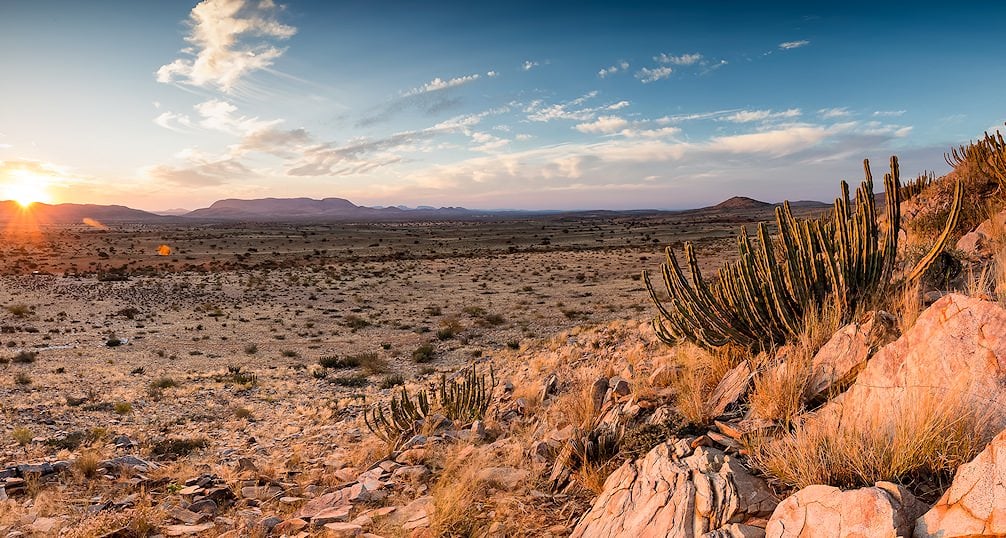
For many years, due to its incredibly remote location and basic rest camp accommodation facilities, Kgalagadi was largely reserved for die-hard self-drive safari enthusiasts. The establishment of the personal !Xaus Lodge within a 50 000-hectare private concession opened the park up to travelers looking for a combination of luxury, convenience and an authentic Kalahari safari. !Xaus can accommodate a total of 32 guests who can enjoy full board accommodation and guided activities like game drives, dune walks and visiting the Bushman craft village. As no telecommunication signals reach the lodge, prepare to truly tune out, disconnect from civilization and immerse yourself in the wildest Africa.
The airport closest to the Kgalagadi Transfrontier Park is in the Northern Cape Town of Upington. From Upington, the overland journey to !Xaus is a roughly four-hour adventure trekking first through farmlands, then wilderness, and finally the deep red dune sea.
If budget isn’t an issue, and you’re looking to really treat yourself to a once-in-a-lifetime safari experience, you’ll find Tswalu Kalahari Private Game Reserve to be a most attractive alternative option. Some 350km by road from Upington (or 1.5 hours from Johannesburg / 2 hours from Cape Town by scheduled charter flight), this 110 000-hectare wilderness is the largest private reserve in the country.
Only 28 guests can be accommodated when both Tswalu’s camps – the Motse and Tarkuni. In addition to its exclusive accommodations, Tswalu offers more diverse big game viewing than Kgalagadi. In addition, the species that you’ll find in the park, two more members of the Big Five occur here – black rhino and Cape buffalo – as well as white rhino, both Burchell’s and Hartmann’s mountain zebras, tsessebe, roan antelope and sable antelope. As in Kgalagadi, however, the magic is often in sighting the smaller mammals rarely spotted other safari areas, particularly aardvark and pangolin.
